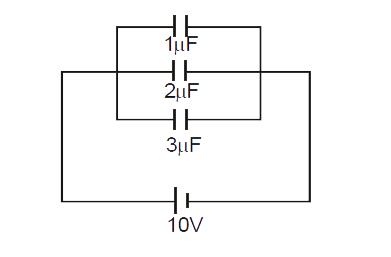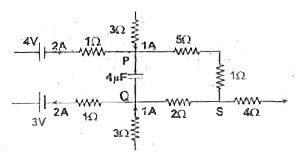Why does current in a steady state not flow in a capacitor connected across a battery? However momentary current does flow during charging or discharging of the capacitor. Explain.
To explain why current does not flow in a capacitor connected across a battery in a steady state, while momentary current does flow during charging or discharging, we can break down the explanation into several steps:
1. Understanding Capacitor Basics:
- A capacitor is a device that stores electrical energy in an electric field, created by a separation of charges. It consists of two conductive plates separated by an insulating material (dielectric).
- When connected to a battery, the capacitor begins to charge, accumulating positive charge on one plate and negative charge on the other.
Hint: Remember that a capacitor's primary function is to store charge, not to allow continuous current flow.
2. Charging Phase:
- Initially, when the capacitor is connected to the battery, it has no charge. As the battery provides voltage, electrons are pushed from the negative terminal of the battery to one plate of the capacitor, creating a negative charge.
- Simultaneously, the other plate of the capacitor becomes positively charged due to the absence of electrons. This movement of electrons constitutes an electric current.
Hint: Consider the role of the battery in providing energy and how it influences the movement of charges.
3. Steady State Condition:
- As the capacitor charges, the voltage across its plates increases until it equals the voltage of the battery. At this point, the capacitor reaches its maximum charge capacity, denoted as Q.
- Once fully charged, the electric field between the plates becomes constant, and the flow of electrons stops. This means that the current flowing into the capacitor drops to zero.
Hint: Think about what happens when the capacitor is fully charged and how it affects the electric field.
4. Displacement Current Concept:
- According to Maxwell's equations, even when there is no actual current flowing through the capacitor in steady state, there is a concept known as displacement current. This occurs due to the changing electric field within the capacitor as it charges or discharges.
- During charging or discharging, the electric field changes, leading to a change in electric flux (ΦE). This change induces a displacement current, which can be expressed mathematically as ID=ϵ0dΦEdt.
Hint: Displacement current is a crucial concept that helps explain how electric fields can influence current flow in circuits even when traditional current is absent.
5. Current Stops in Steady State:
- Once the capacitor is fully charged, the charge on the plates becomes constant, meaning the electric field is also constant. Therefore, the rate of change of electric flux becomes zero (dΦEdt=0), leading to zero displacement current.
- Since there is no displacement current, there is no flow of conventional current in the circuit.
Hint: Reflect on how the relationship between charge, electric field, and electric flux affects the flow of current.
Summary:
In summary, current flows during the charging and discharging of a capacitor due to the movement of charges. However, in a steady state, once the capacitor is fully charged, the electric field stabilizes, and the rate of change of electric flux becomes zero, resulting in no current flow. The displacement current concept helps explain the behavior of electric fields in such scenarios.
- A capacitor is a device that stores electrical energy in an electric field, created by a separation of charges. It consists of two conductive plates separated by an insulating material (dielectric).
- When connected to a battery, the capacitor begins to charge, accumulating positive charge on one plate and negative charge on the other.
- Initially, when the capacitor is connected to the battery, it has no charge. As the battery provides voltage, electrons are pushed from the negative terminal of the battery to one plate of the capacitor, creating a negative charge.
- Simultaneously, the other plate of the capacitor becomes positively charged due to the absence of electrons. This movement of electrons constitutes an electric current.
- As the capacitor charges, the voltage across its plates increases until it equals the voltage of the battery. At this point, the capacitor reaches its maximum charge capacity, denoted as Q.
- Once fully charged, the electric field between the plates becomes constant, and the flow of electrons stops. This means that the current flowing into the capacitor drops to zero.
- According to Maxwell's equations, even when there is no actual current flowing through the capacitor in steady state, there is a concept known as displacement current. This occurs due to the changing electric field within the capacitor as it charges or discharges.
- During charging or discharging, the electric field changes, leading to a change in electric flux (ΦE). This change induces a displacement current, which can be expressed mathematically as ID=ϵ0dΦEdt.
- Once the capacitor is fully charged, the charge on the plates becomes constant, meaning the electric field is also constant. Therefore, the rate of change of electric flux becomes zero (dΦEdt=0), leading to zero displacement current.
- Since there is no displacement current, there is no flow of conventional current in the circuit.
In summary, current flows during the charging and discharging of a capacitor due to the movement of charges. However, in a steady state, once the capacitor is fully charged, the electric field stabilizes, and the rate of change of electric flux becomes zero, resulting in no current flow. The displacement current concept helps explain the behavior of electric fields in such scenarios.
Topper's Solved these Questions
- ELECTROSTATIC POTENTIAL AND CAPACITANCE BOOK - MODERN PUBLICATIONCHAPTER - ELECTROSTATIC POTENTIAL AND CAPACITANCE EXERCISE - Revision Exercises (Long Answer Questions)
13 Videos
- ELECTROSTATIC POTENTIAL AND CAPACITANCE BOOK - MODERN PUBLICATIONCHAPTER - ELECTROSTATIC POTENTIAL AND CAPACITANCE EXERCISE - Revision Exercises (Numerical Problems)
25 Videos
- ELECTROSTATIC POTENTIAL AND CAPACITANCE BOOK - MODERN PUBLICATIONCHAPTER - ELECTROSTATIC POTENTIAL AND CAPACITANCE EXERCISE - Revision Exercises (Fill in the Blanks)
11 Videos
- ELECTROMAGNETIC WAVESBOOK - MODERN PUBLICATIONCHAPTER - ELECTROMAGNETIC WAVESEXERCISE - CHAPTER PRACTICE TEST
14 Videos
- MAGNETISM AND MATTERBOOK - MODERN PUBLICATIONCHAPTER - MAGNETISM AND MATTEREXERCISE - CHAPTER PRACTICE TEST FOR BOARD EXAMINATION
16 Videos
Similar Questions
Knowledge Check
Displacement current is maximum during charging of capacitor. When charge on the capacitor is
AMaximumBMinimumCAny value of chargeDDepends on nature of capacitorDuring charging of capacitor, IC. is the conduction current flowing in the wires connecting capacitor to the battery and Id is the Displacement current flowing between the plates of the capacitor.
AIc>IdBIc<IdCIc=IdDNo relation exists between ic and IdAssertion (A) : A lamp is connected in series with a capacitor and ac source connected across their terminal consequently current flow in the circuit and the lamp will shine.
Reason (R ) : Capacitor block dc current and allow ac currentABoth Assertion and Reason are true and Reason is the correct explanation of Assertion.BBoth Assertion and Reason are true but Reason is not the correct explanation of Assertion.CAssertion is true but Reason is falseDAssertion is false but Reason is true
How does current flow in a circuit?
View SolutionWhen a parallel plate capacitor is connected across a d.c. battery. Explain briefly how the capacitor gets charged .
View SolutionThree initially uncharged capacitors are connected to a battery of 10 V in parallel combination. Find out the following ?
charge flow from the battery
View SolutionFigure shows a parallel plate capacitor and the current in the connecting wires that is discharging the capacitor.
View SolutionA part of a circuit in steady state with the currents flowing in a braches , the value of resistance etc is shown in the figure.

Charge on the capacitor is
View Solution

